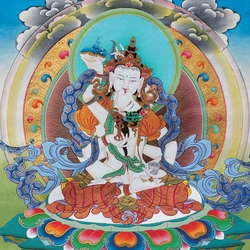༄༅། །ན་རཀ་སྐོང་བཤགས་ཀྱི་བཀླག་ཐབས།
The Recitation Guide for Narak Kongshak
ཆོ་ག་གཞན་དང་མ་འབྲེལ་བར་ན་རག་སྐོང་བཤགས་རྐྱང་པ་གཏོང་བའི་ཚེ། ཚིག་བདུན་གསོལ་འདེབས་སོགས་གང་རིགས་སྔོན་དུ་འགྲོ་བས།
When you practice Narak Kongshak by itself without combining it with any other ritual, first chant The Seven-Line Supplication and other suitable supplications and then say:
བླ་མ་རིག་འཛིན་རྒྱལ་བ་ཞི་ཁྲོའི་དཀྱིལ་འཁོར་གྱི་ལྷ་ཚོགས་ཐམས་ཅད་མདུན་གྱི་ནམ་མཁར་བཛྲ་ས་མཱ་ཛ༔
lama rikdzin gyelwa zhi trö kyilkhor gyi lha tsok tamché dün gyi namkhar benza samadza༔
The entire assembly of vidyādhara gurus and deities of the mandalas of peaceful and wrathful victors are present in the sky before me—vajra samāja༔
རྡོ་རྗེ་སློབ་དཔོན་སངས་རྒྱས་དཔལ། སོགས་ཡན་ལག་བརྒྱད་པ་ལན་གསུམ།
Then chant the eight branches beginning “Vajra master, glorious buddha,” three times.
བཀའ་མ་ཡན་ལག་བརྒྱད་པ་ནི།
The eight branches from the Kama (Oral Transmission):
ཧོཿ རྡོ་རྗེ་སློབ་དཔོན་སངས་རྒྱས་དཔལ། །
hoh, dorjé lopön sangyé pel
Hoḥ! Vajra master, glorious buddha
དུས་གསུམ་བཞུགས་ལ་ཕྱག་འཚལ་ལོ། །
düsüm zhuk la chaktsel lo
abiding throughout the three times, I bow before you.
མཆོག་གསུམ་བསྟེན་པའི་ཞིང་གྱུར་ལ། །
chok sum tenpé zhing gyur la
With an undivided mind, I take refuge in those who are
གཉིས་མེད་ཡིད་ཀྱིས་སྐྱབས་སུ་མཆི། །
nyimé yi kyi kyap su chi
the basis for the teachings of the Three Jewels.
དངོས་བྱོར་ཡིད་ཀྱིས་རྣམ་སྤྲུལ་པའི། །
ngöjor yi kyi nam trülpé
Please accept these pure offerings,
དག་པའི་མཆོད་པ་བཞེས་སུ་གསོལ། །
dakpé chöpa zhé su söl
both actually present and mentally created.
དངོས་གྲུབ་ཆུ་བོ་གཅོད་པའི་བགེགས། །
ngödrup chuwo chöpé gek
I apologize without exception for all misdeeds,
ཉེས་བྱེས་མ་ལུས་བཤགས་པར་བགྱི། །
nyé jé malü shakpar gyi
the hindrances that bar the river of accomplishment.
ཕྱོགས་བཅུ་འཁོར་གསུམ་དག་པའི་ཆོས། །
chok chu khor süm dakpé chö
I rejoice in non-attached conduct throughout the ten directions,
མ་ཆགས་སྤྱོད་ལ་རྗེས་ཡི་རང༌། །
machak chö la jé yirang
which is free from conceptualization of the three spheres.
དག་པའི་མཐའ་བཞི་དྲི་མ་མེད། །
dakpé ta zhi drima mé
I form the resolve towards complete awakening,
རྫོགས་པའི་བྱང་ཆུབ་སེམས་བསྐྱེད་དོ། །
dzokpé jangchup sem kyédo
pure and untainted by the four extremes.
བདེ་གཤེགས་བྱང་ཆུབ་སེམས་དཔའ་ལ། །
déshek jangchup sempa la
I offer my body of three purities
དག་པ་གསུམ་གྱི་ལུས་འབུལ་ལོ། །
dakpa sum gyi lü bülo
to the sugatas and bodhisattvas.
ཚེ་རབས་བགྲངས་པའི་ལས་རྣམས་ཀུན། །
tsé rap drangpé lé nam kün
I add up all virtue from my every lifetime
བསྡུས་ཏེ་བླ་མེད་མཆོག་དུ་བསྔོ། །
dü té lamé chok tu ngo
and dedicate it to supreme awakening.
སེམས་ཅན་བདེ་དང་ལྡན་གྱུར་ཅིག །
semchen dé dangden gyur chik
May all beings live in happiness.
སྡུག་བསྔལ་ཀུན་དང་འབྲལ་བར་ཤོག །
duk-ngel kün dang drelwar shok
May they be free from all suffering.
བདེ་དང་རྟག་ཏུ་མི་འབྲལ་ཞིང༌། །
dé dang taktu midrel zhing
May they never be apart from happiness.
ཆོས་ཀུན་མཉམ་ཉིད་རྟོགས་པར་ཤོག །
chö kün nyam-nyi tokpar shok
May they realize the equality of all things.
ཛཿཧཱུྃ་བྃ་ཧོཿ
dza hum bam hoh
jaḥ hūṃ baṃ hoḥ
སྐྱབས་ཡུལ་རྣམས་རང་ལ་ཐིམ།
kyap yül nam rang la tim
The objects of refuge dissolve into me.
རང་ཉིད་སྐད་ཅིག་གིས་དཔལ་རྡོ་རྗེ་སེམས་དཔའི་སྐུར་གྱུར། །
rang nyi kéchiki pel dorje sempé kur gyur
Instantly I become the awakened form of glorious Vajrasattva.
ཅེས་པ་ལྟ་བུའི་གཉུག་མའི་ལྷ་གང་ཡང་རུང་བར་གསལ་བས།
With that, visualize the innate deity, whichever it may be, and then say:
ༀ་ཧཱུྃ་ཏྲཱྃ་ཧྲཱིཿཨཿ
om hum tram hrih ah
oṃ hūṃ trāṃ hrīḥ aḥ
ལྷ་རྫས་དང་ཏིང་ངེ་འཛིན་ལས་གྲུབ་པའི་ཕྱི་ནང་གསང་བའི་མཆོད་སྤྲིན་ངོ་བོ་ཡེ་ཤེས་ཀྱི་བདུད་རྩི་ལ་རྣམ་པ་འདོད་ཡོན་གྱི་སྤྲིན་ཕུང་ཟད་མི་ཤེས་པ་ཀུན་ཏུ་བཟང་པོའི་མཆོད་པའི་རྣམ་རོལ་དུ་རྒྱས་པར་གྱུར་ཅིག །
lha dzé dang ting ngé dzin lé drupé chi nang sangwé chötrin ngowo yeshé kyi dütsi la nampa döyön gyi trinpung zé mishépa küntu zangpö chöpé namröl du gyepar gyur chik
May these clouds of outer, inner, and secret offerings made from divine substances and samadhi—in essence wisdom amrita but appearing as inexhaustible cloudbanks of sense pleasures—increase to become a display of Samantabhadra offerings!
ཅེས་མཆོད་པའི་བྱིན་རླབས་སྔགས་དང་རོལ་མོ་བཅས་བྱ།
Make music and recite the mantra for consecrating the offerings. Then say:
རང་གི་སྙིང་ག་ནས་འོད་ཟེར་འཕྲོས་པས་བླ་མ་རིག་འཛིན་རྒྱལ་བ་ཞི་ཁྲོ་རྩ་གསུམ་ཆོས་སྲུང་རབ་འབྱམས་ཀྱི་ཚོགས་རྣམས་མདུན་གྱི་མཁར་བཛྲ་ས་མཱ་ཛ༔
rang gi nying ka né özer tröpé lama rikdzin gyelwa zhitro tsasum chösung rapjam kyi tsok nam dün gyi namkhar benza samadza༔
Rays of light shining forth from my heart center invite the all-encompassing hosts of vidyādhara gurus, peaceful and wrathful victors, three roots, and Dharma protectors to be present in the sky before me—vajra samāja༔
ཨེ་མ་ཧོ༔ ཕྱོགས་བཅུ་དུས་བཞི་སོགས་ནས། ཕྱག་མཆོད་བཞེས༔ ཞེས་གདངས་དང་བཅས་པའི་མཐར་རོལ་མོ། ཡོན་ཏན་ཕུན་ཚོགས་སོགས་ནས་བསྐང་བ་བསྡུས་པའི་བར་གཞུང་ལྟར། མཐར། བླ་མ་ཡི་དམ་སོགས་བསྔོ་སྨོན་དང༌། ཤིས་བརྗོད་ཅི་རིགས་བྱའོ། །ཅེས་པའང་མཁྱེན་བརྩེའི་དབང་པོས་སོ། །མངྒ་ལཾ།། །།
Now sing the first four lines from “Emaho!༔ We call upon all the great enlightened beings...” ending with “...and even the lower realms.༔” and make music. Then continue through the liturgy from “To all the masters endowed with perfect qualities...” down to the brief fulfillment offering according to the liturgy. At the end, chant suitable dedications, aspirations, and prayers for auspiciousness such as that beginning “Lamas and hosts of yidam deities, turn your attention towards us!”1 This was written by Khyentsé Wangpo. mangalaṃ
Rangjung Yeshe & Lhasey Lotsawa Translations (trans. Erik Pema Kunsang, checked against the Tibetan and edited by Laura Dainty), 2019.
2.0_2019_06_10_LD
2.0_2019_08_27_OL
2.1_20200430_OL
- ↑ The Secret Vajra Knot: An Aspiration Prayer of the Three Yogas by Minling Terchen Rikdzin Gyurmé Dorjé, translated by Lotsawa House.

